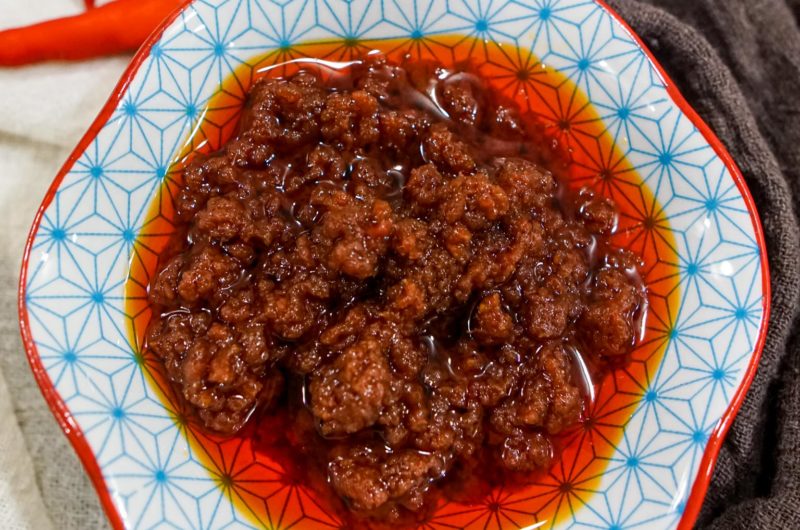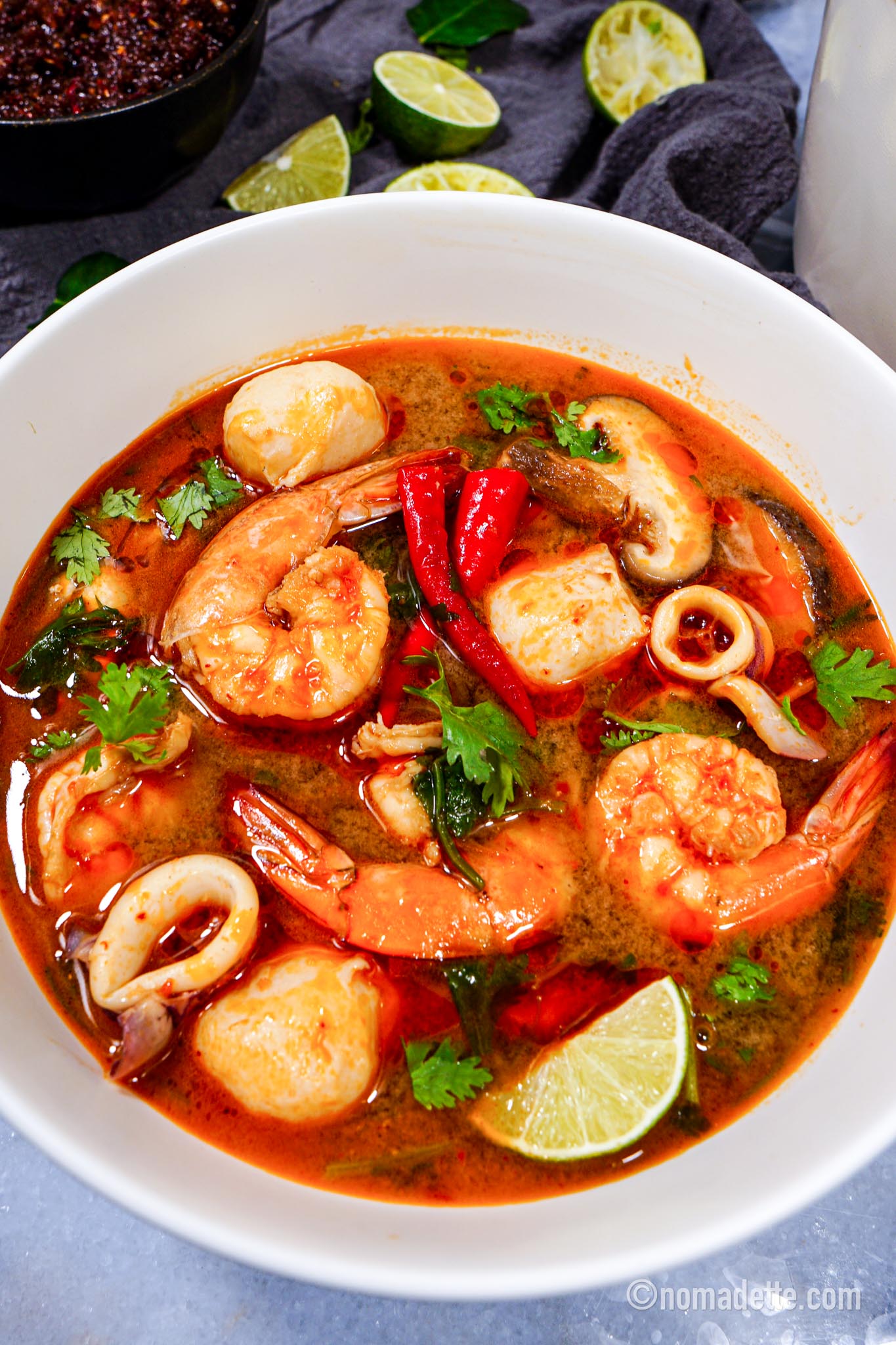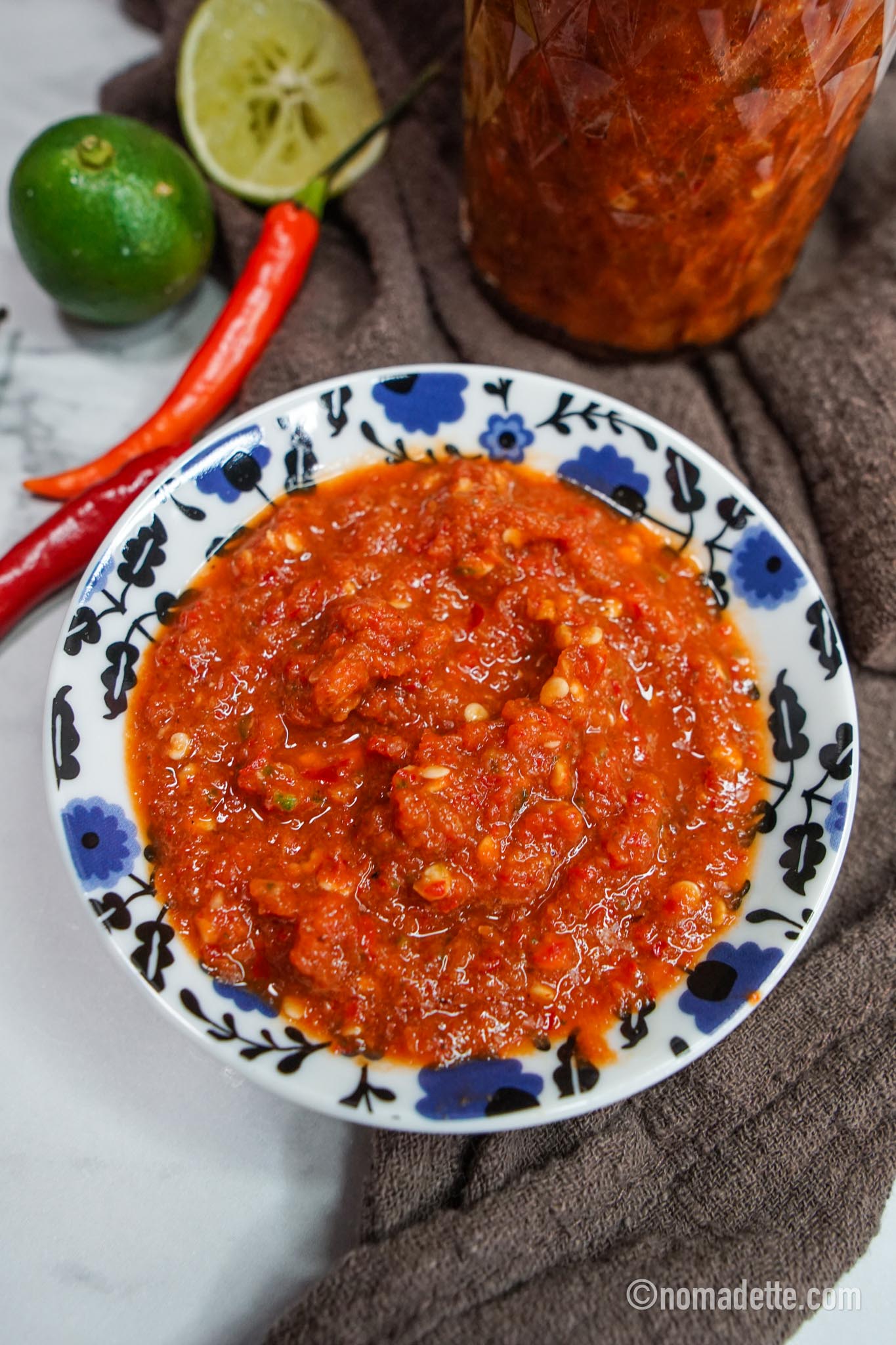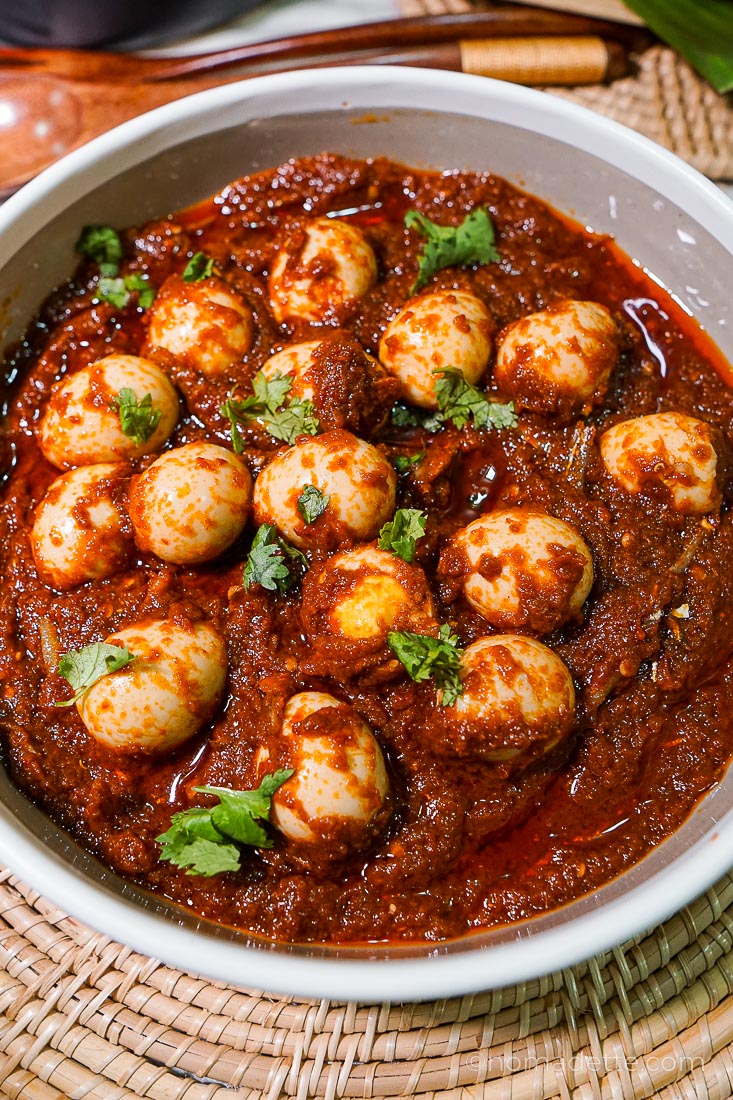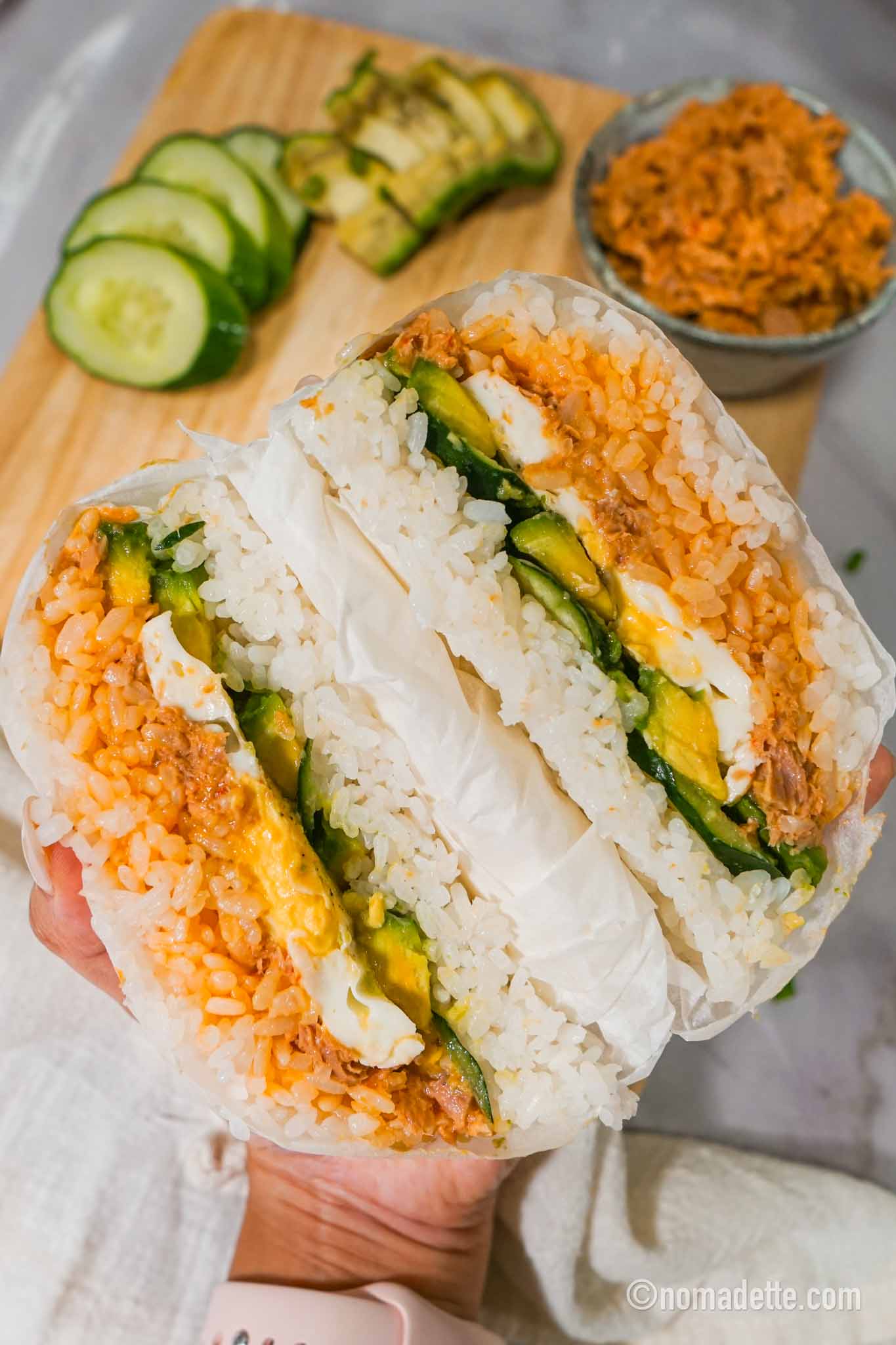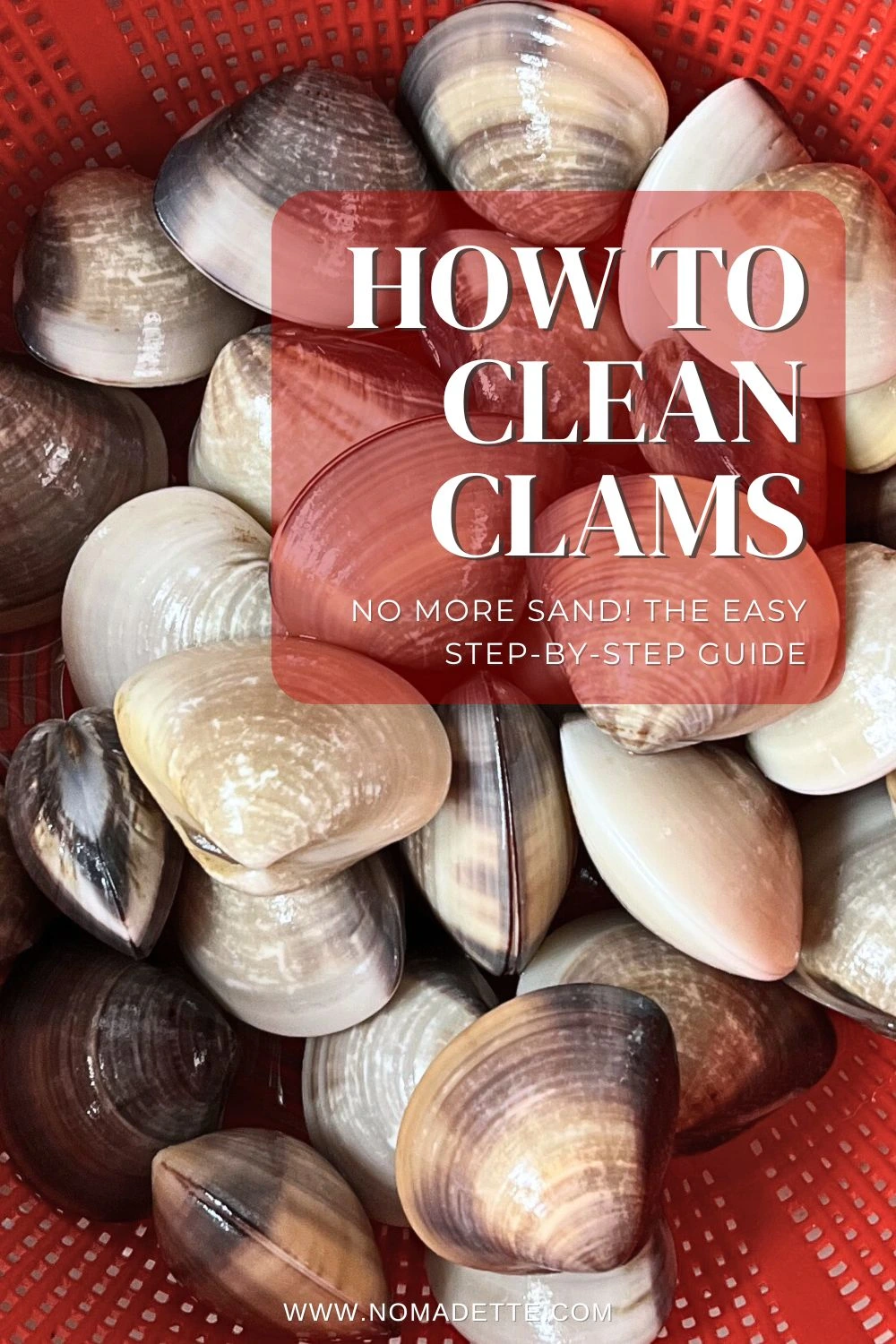This is the only basic Sambal recipe you need! Spice up your kitchen adventures with an easy, beginner-friendly spicy sambal recipe that’s as versatile as it is delicious.

If there’s one condiment that rule Southeast Asia, it has to be Sambal! Making this bold sauce at home can be as intimidating as the spice levels itself! In this blog post, I’ll show you how to make the simplest, most basic sambal from scratch, to start you off on your Sambal-making journey.
Sambal is the fiery and flavourful chili sauce – a true gem in the world of condiments. I make A LOT of Sambal here.
Why You’ll Love This Recipe
Sambal is a beloved condiment for a reason. Its vibrant flavours and fiery kick can elevate any meal. Here are some reasons why you’ll fall in love with this recipe:
- Minimal Ingredients: This recipe requires just THREE base ingredients to make a good sauce.
- Versatile: This recipe is incredibly versatile. Use it as a dipping sauce, a condiment, a base for other dishes, marinade, or condiment to add a spicy punch to a wide variety of dishes.
- Customisable Heat Level: You can adjust the spiciness to suit your taste buds. Love it hot? Add more chili peppers. Prefer milder? Reduce the quantity.
- Packed with Flavour: Sambal is not just about heat; it’s also about rich, complex flavors. The combination of chilies, garlic, shallots, and other ingredients creates a symphony of tastes that’s simply irresistible.
Key Ingredients for Basic Sambal
Before we dive into the recipe, let’s take a quick look at the key ingredients you’ll need:
Dried Red Chilli Peppers
These are the star of the show, responsible for the sauce’s heat. In Singapore and Malaysia, we use Spur dried chillies, Byadgi dried chillies or Kashmiri dried chillies, although the packets would simply be labelled “Dried Chillies”. These are medium-heat chillies, and versatile.
Any type of dried chillies can work for Sambal, as long as it’s a medium heat level. I would not recommend anything spicier than that because it would be too hot to handle – such as dried Thai bird’s eye chillies.
Other types of dried chillies (or chiles/chilies) that you can use would be:
- Guajillo Dried Chillies (most common and closest in form and flavour)
- Fresno Dried Chillies
- Serrano Dried Chillies
The prep required (see Step 1 below) for all the dried chillies are the same!
If you would like to try Sambal, but afraid that the heat might be too intense, feel free to use a milder red chilli pepper.
Garlic & Onion
These are the only two aromatics you need to make sambal with some depth of flavour! Onions will add a hint of sweetness and creamy bulk, while garlic adds a robust and aromatic flavour.
I used Red Onions, but any type of onions such as yellow onions or shallots will work for this.
Other Ingredients
- Salt and Sugar will flavour and balance out the spicy flavours.
- Water: For an easier blend, I added water. You can also use oil instead, but I prefer to use water.
- Oil: Any neutral-tasting oil such as vegetable oil, canola oil and soybean oil will work. Sambal requires A LOT of oil to cook it down, so don’t skimp on this!
- Tamarind Paste: Optional, but I like to add tamarind paste to balance out the spicy, sweet and salty flavours. If you cannot find tamarind paste, or want to keep this simple, omit from the recipe. Once you try adding tamarind paste however, you won’t be able to skip this ingredient after!
How to Make Basic Sambal
Now, let’s get to the fun part – making the rich sauce at home!
Step 1: Prepare the Ingredients

The most important step to Sambal is to prep the dried chillies.
There are a few ways to prep dried chillies, you can read more on this in this post.
Give the dried chillies a quick rinse and add to a heatproof bowl. If there are any stems, cut them off.
Pour hot, boiling water over the dried chillies and allow to soak for about 5 minutes, or until the dried chillies rehydrate and soften. Drain off the liquid.
Cut the chillies into smaller pieces for easier blending. Option to remove the seeds for a milder Sambal. I never do. Some might say the seeds make the dried chilli paste bitter, but I personally haven’t experienced this with the Spur/Kashmiri chillies. If you find the dried chilli paste to have a bitter aftertaste, try removing the chillies.
TIP! Minimise handling the chillies with your bare hands as they can sting! I use to use gloves to handle them as I’m chopping the chillies. Now my preferred method is to simply use a pair of scissors to cut the chillies.
For the garlic and onions, peel the aromatics and rough chop to smaller pieces.
Step 2: Blend the Sambal
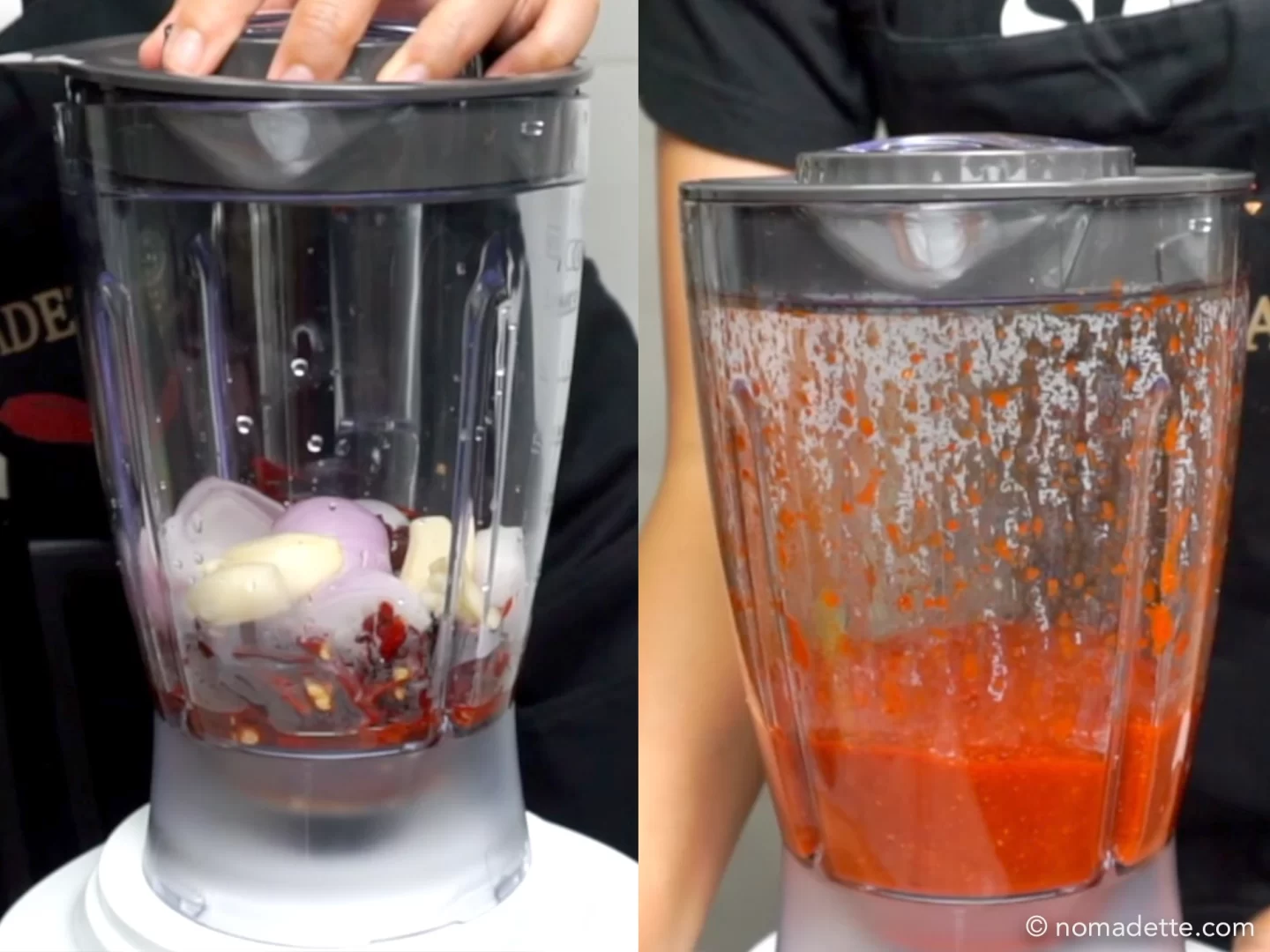
Add the dried chillies, garlic and onions to a blender. Add water or oil to allow the blender to blend smoother. Give blender a blitz until a smooth paste forms.
If paste is not blending smoothly, gradually add water bit by bit. We do not want to add too much water as well, since this will result in an even longer cook time.
You can also use a food processor too, but you might not be able to achieve as smooth a paste as with a blender.
Traditionally, a mortar and pestle is used to pound to a smooth paste. With this traditional method, we use the most minimal amount of liquid to get the dried chilli paste… BUT a lot more muscle power and time is required to get a smooth paste.
Step 3: Cook down the Dried Chilli Paste
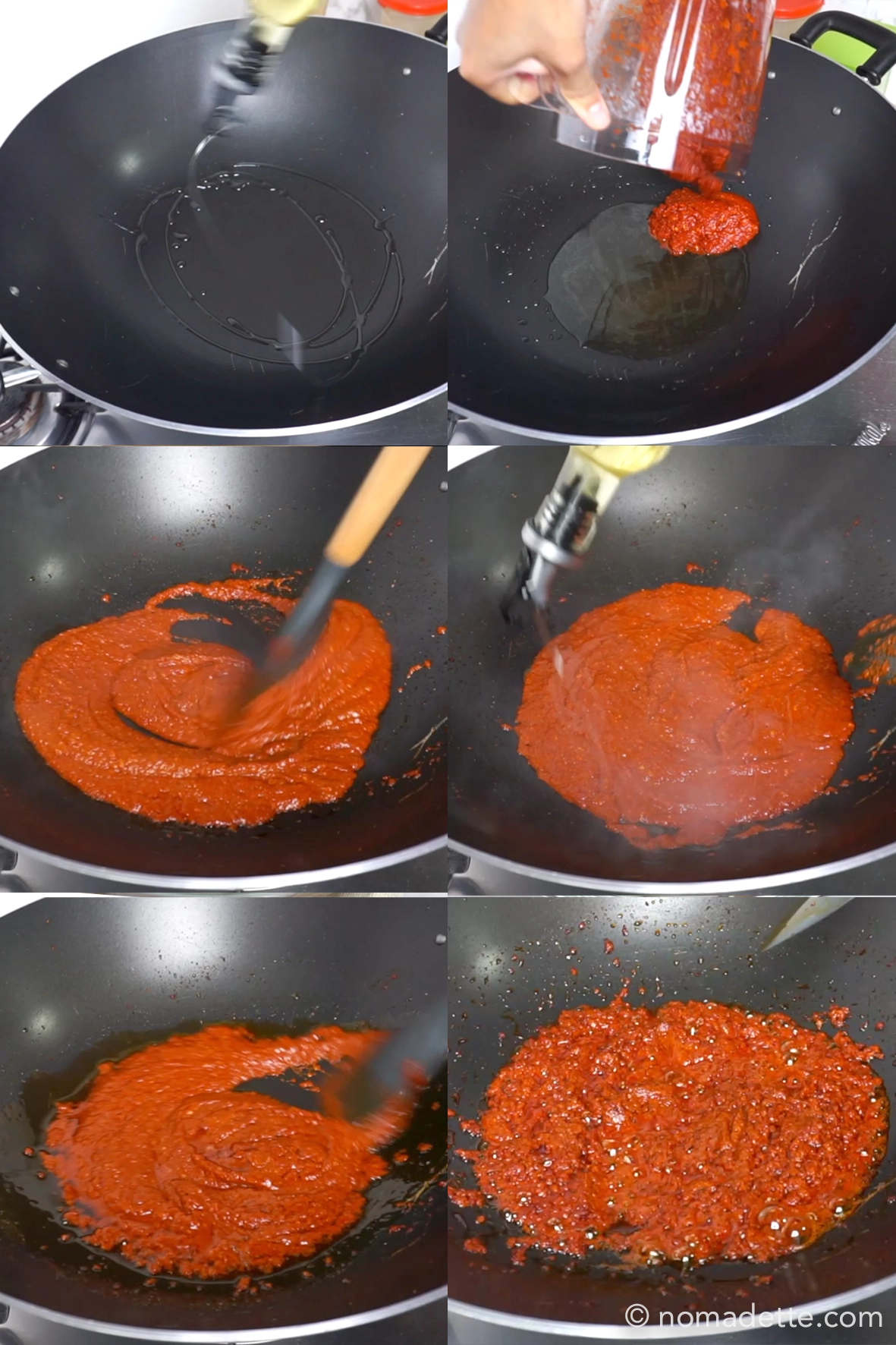
This is the most crucial step to making Sambal – that is to properly cook it down!
Add a lot of oil to the pan or wok. Keep additional oil on the side. Heat over low heat. Use a low heat so the sambal does not burn. IF it burns, that will leave a bitter aftertaste.
Once the oil is hot, add the dried chilli paste. Continuously stir fry over the low heat.
The chilli paste will begin to dry down and emulsify as it cooks down. There might be some oil splatter, this is normal. Keep heat on a low to minimise the splatters.
These are the three signs you can expect to ensure a properly cooked down Sambal:
- The oil will begin to turn red. It will also begin to release itself from the dried chilli paste, and float above the chilli paste.
- The chilli paste will begin to dry down and come together in a rich, thick paste.
- The chilli paste will begin to turn a deeper, darker red.
Step 4: Adjust the Seasoning
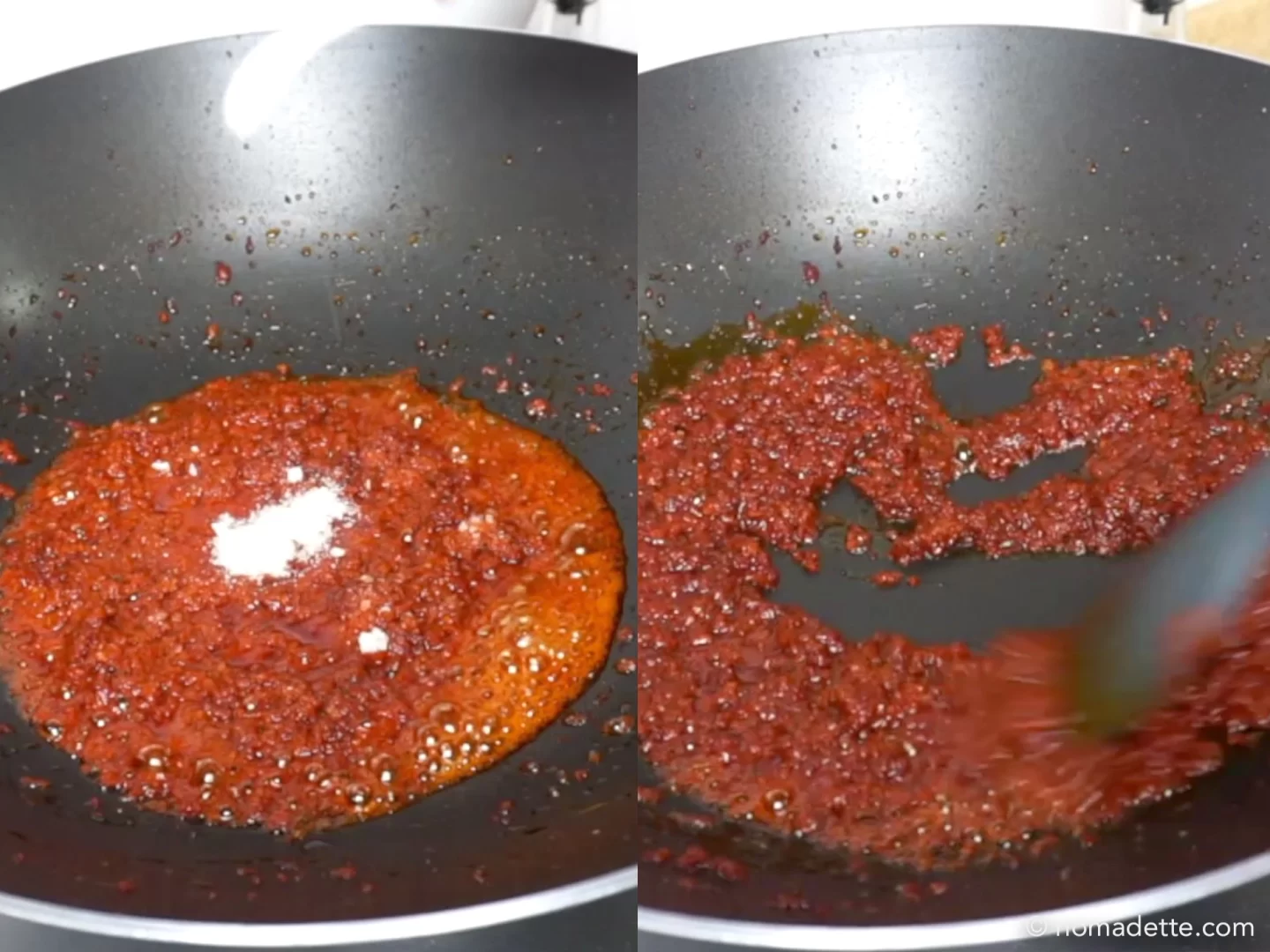
Once the chilli paste has emulsified, the sambal is almost ready! Now it’s time to season with sugar and salt.
Give it another stir to combine.
Always make sure to taste it and adjust the seasoning accordingly.
Step 5: Serve and Store
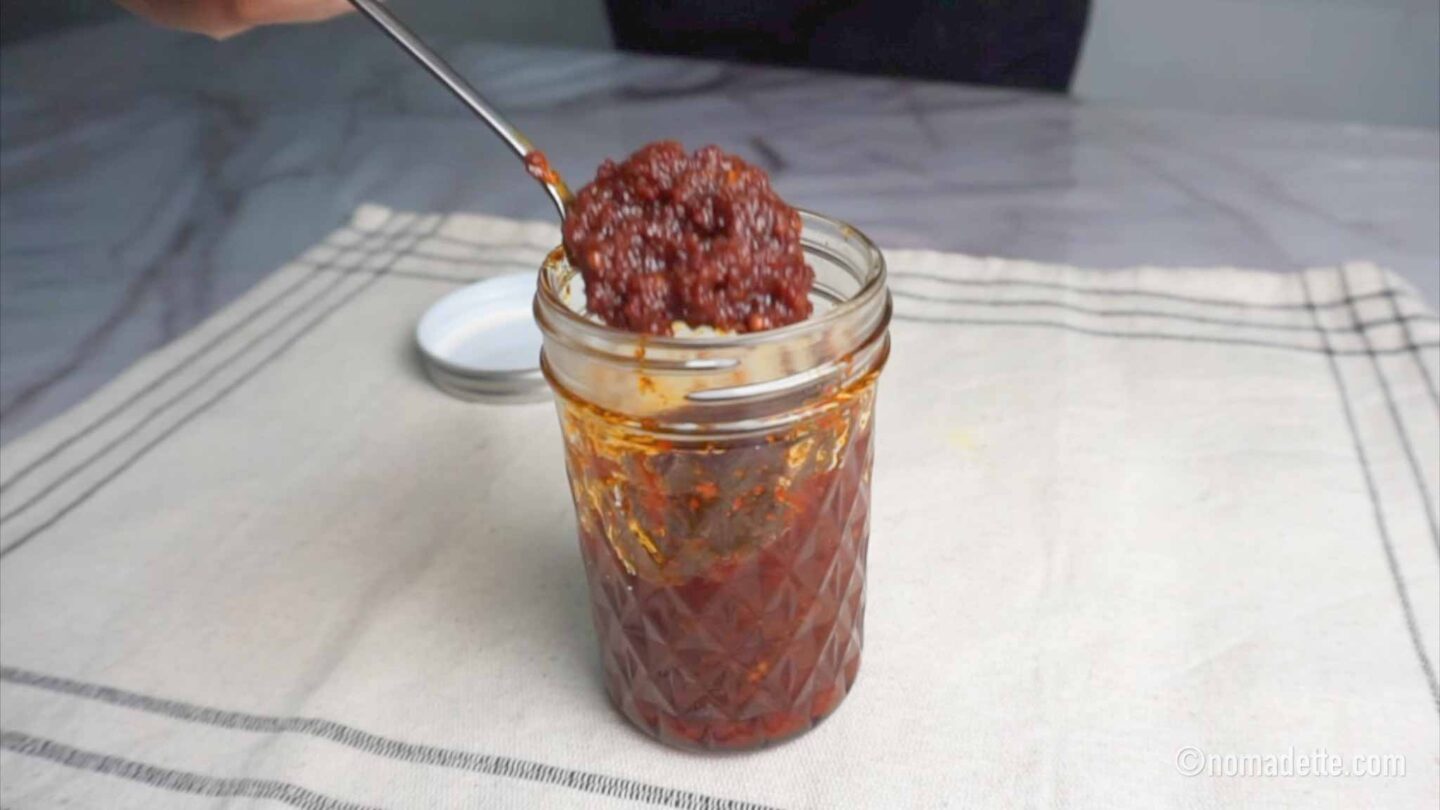
Once you’re happy with the taste, turn off the heat. Sambal is ready for use!
If you followed this recipe, it’s likely you will have extra – and you SHOULD always make extra! This recipe makes about 400ml or almost 2 cups of sauce. Sambal is simple to make, but it’s not quite a 5-minute recipe.
How to Store Sambal?
Once cooked proper, Sambal can be stored for about 1 month in the fridge! To ensure longevity:
- Clean and dry the container Sambal will be stored in. I like to use a glass jar. After washing the glass jar, air dry until completely dry. It’s important that there is no liquid left in the jar before adding the Sambal.
- Sanitise the Jar: After it dries, I like to sanitise it further by blitzing the glass jar in the microwave. Set it on high and blitz for 5 minutes. If jar has a metal cover, remove it before placing jar in microwave!
- Ensure Sambal is submerged in oil.
- Store in the fridge.
- Use a clean spoon to scoop out sauce each time.
With these steps I can prolong the shelf life of my Sambal beyond a month even. Of course, if Sambal smells off, or if there is white mold developing, discard immediately.
Versatile Uses for Sambal
Now that you have your homemade sambal, let’s explore its versatile uses:
- Condiment: Sambal can be used as a condiment to eat with rice and the accompanying dishes for a rich and spicy flavour kick.
- Base Sauce for Dishes: Malay recipes require dried chilli paste as its base. Use this ready-made Sambal instead! You skip the long cook down time required for dried chili paste, which means you get to the final dish quicker and more effortlessly. Some easy recipes you can try: Mee Goreng, Ayam Masak Merah, and Ayam Paprik.
- Stir-Fries: Add a spoonful of sambal to your stir-fry dishes for an extra layer of heat and flavour. Use this to spice up my noodle stir fries such as Char Kway Teow.
- Marinade: Use sambal as a spicy marinade for chicken, shrimp, or tofu! Slather on the sambal, before grilling, roasting or even air frying!
- Dipping Sauce: This can be used as a spicy dipping sauce for fried chicken or any other fried snacks.
- Soup Enhancer: A little sambal can transform a plain bowl of soup into a spicy delight. A dollop of this in Laksa, chicken noodle soup or even a classic tomato soup will give it a spicy richness.
Ready to Level it Up?
Once you get the hang of making a basic sambal, and the fundamentals of the ‘oil splitting’ or ‘pecah minyak’ process, it’s time to level up your sauce! Add ingredients such as lemongrass, ginger, galangal, belacan or terasi or dried shrimps to bring your Sambal to restaurant-quality.
These are some recipes you can try:
- How I usually Make My Sambal
- The BEST Sambal for Nasi Lemak! (a TOP hit on my blog!)
- Singapore Hawker Style Sambal Chilli


